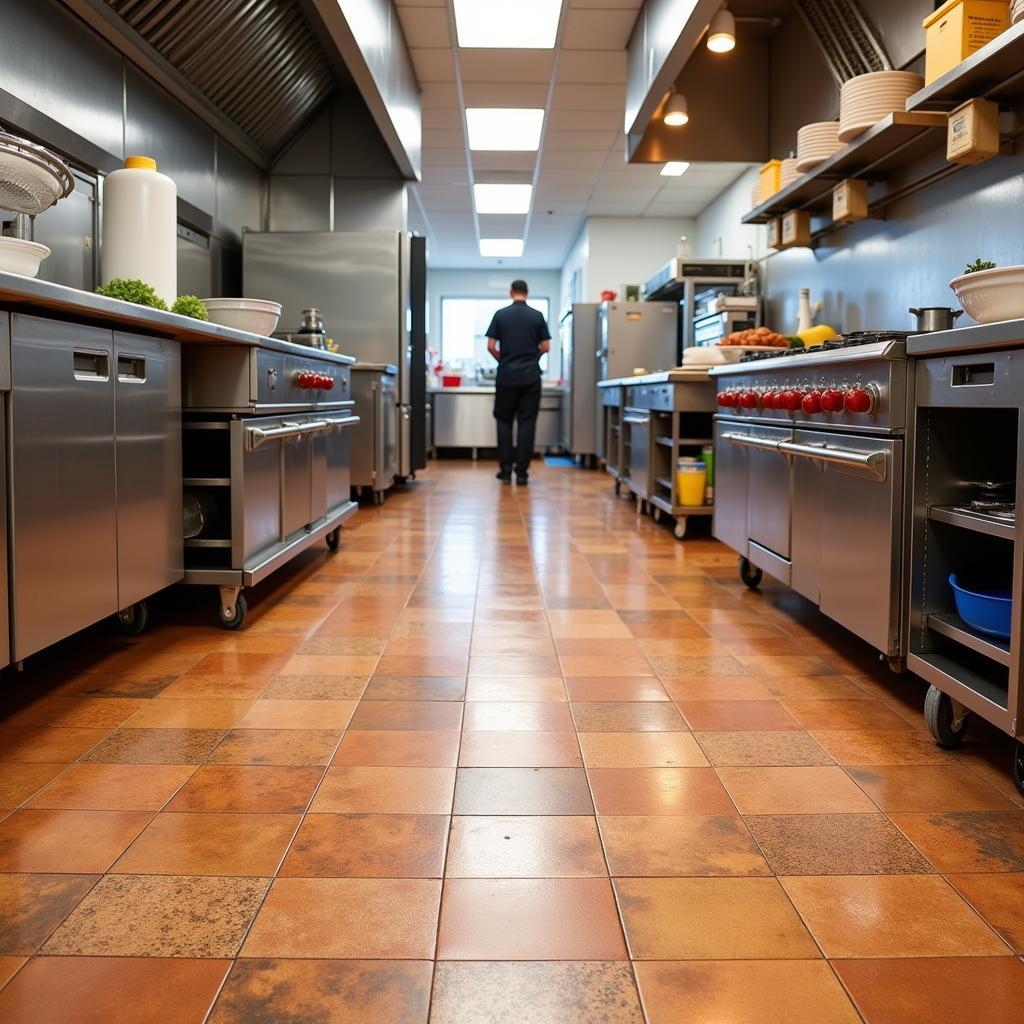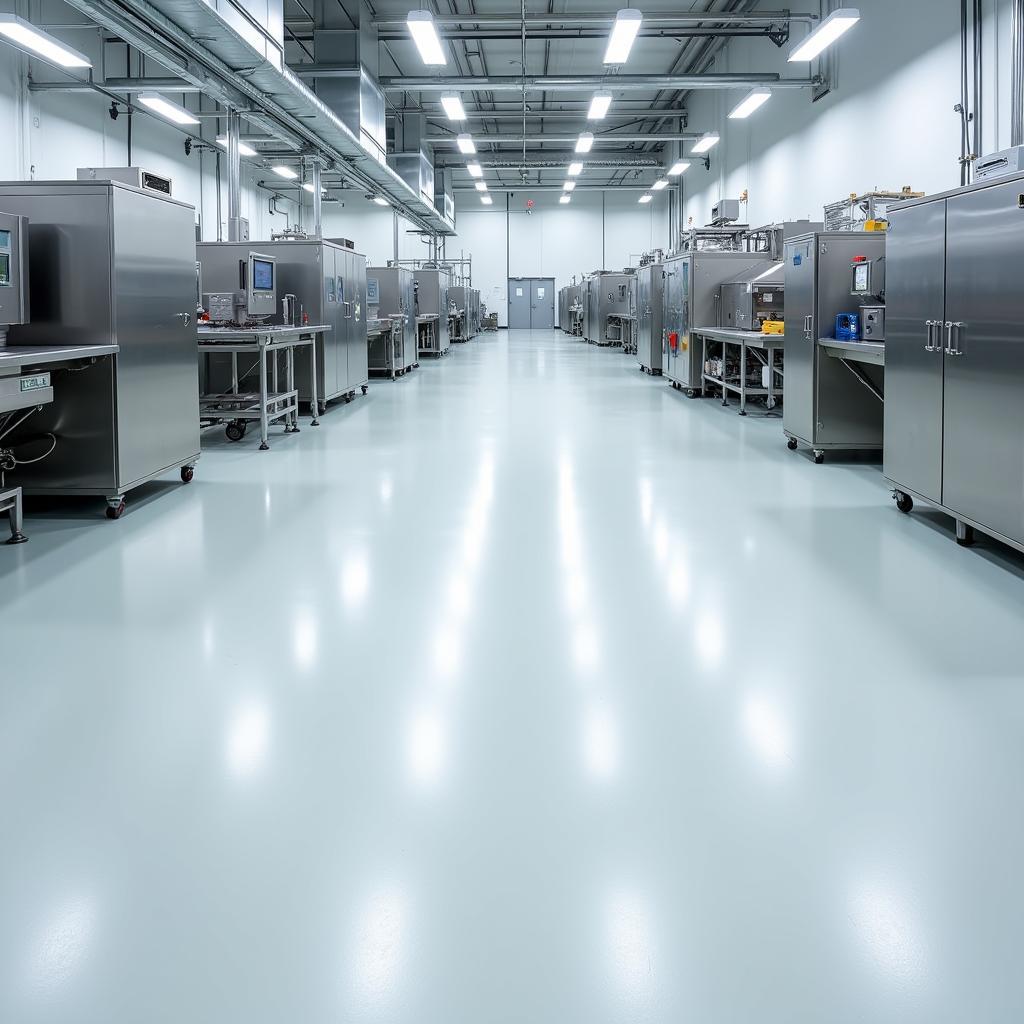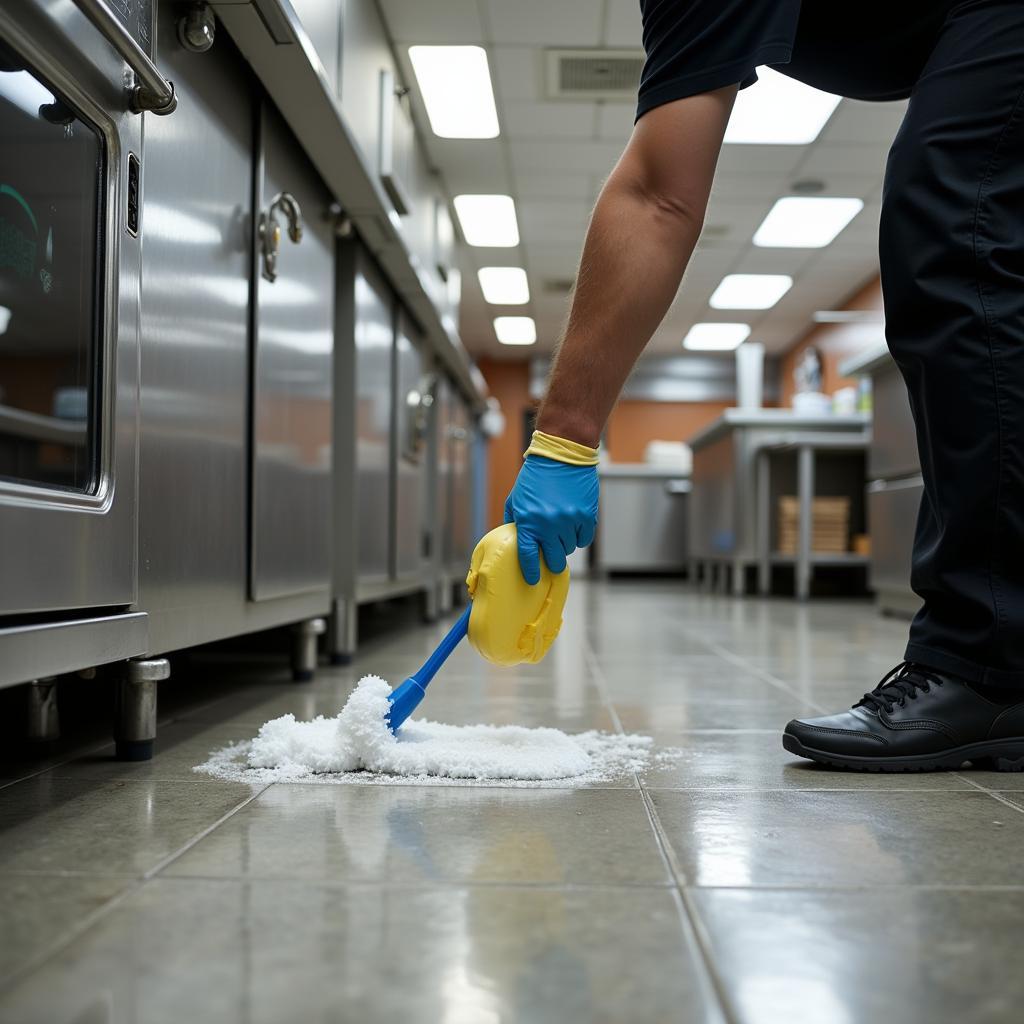Food Grade Flooring is more than just a stylish addition to your commercial kitchen, food processing plant, or even your home pantry. It’s a critical investment in safety and hygiene, ensuring the integrity of your food products and the well-being of everyone who consumes them. Choosing the right flooring isn’t just about aesthetics; it’s about meeting stringent health and safety standards while ensuring durability and longevity.
Why is Food Grade Flooring Important?
Imagine this: a busy restaurant kitchen bustling with activity. Pots are clanging, knives are chopping, and delicious aromas fill the air. But beneath the surface, unseen dangers may lurk if the flooring isn’t up to par.
Food grade flooring acts as a protective barrier against potential hazards like:
- Bacterial Growth: Spills, crumbs, and moisture create a breeding ground for bacteria. Food grade flooring, with its non-porous surface, prevents these contaminants from seeping in and multiplying.
- Slip and Fall Accidents: Grease, water, and food particles can turn a kitchen floor into a skating rink. Food grade flooring options often come with textured surfaces or slip-resistant coatings to minimize the risk of accidents.
- Chemical Contamination: From cleaning agents to food ingredients, spills can happen. Food grade flooring is designed to resist staining and damage from harsh chemicals, ensuring that your food remains untainted.
 Commercial Kitchen with Food Grade Flooring
Commercial Kitchen with Food Grade Flooring
What Makes Flooring “Food Grade”?
Not all flooring is created equal, especially when it comes to food safety. So, what sets “food grade” apart?
Here are the key characteristics to look for:
- Non-Porous Surface: The surface should be smooth and impermeable, preventing liquids, bacteria, and other contaminants from penetrating the flooring.
- Slip Resistance: A textured surface or a slip-resistant coating is crucial, especially in areas prone to spills and moisture.
- Durability and Impact Resistance: Food service environments are demanding. The flooring must be able to withstand heavy foot traffic, impacts from dropped objects, and the movement of heavy equipment without cracking or chipping.
- Chemical Resistance: Exposure to cleaning agents, sanitizers, and food ingredients is inevitable. Food grade flooring should resist staining, discoloration, and deterioration caused by these substances.
Types of Food Grade Flooring
Choosing the right type of food grade flooring depends on your specific needs, budget, and the level of traffic your space experiences. Here are some popular options:
1. Epoxy Flooring
Epoxy flooring is a popular choice for commercial kitchens, food processing plants, and bakeries. It’s known for its:
- Exceptional Durability: Epoxy flooring can withstand heavy loads, impact, and constant use.
- Seamless Finish: The seamless application creates a smooth, hygienic surface that’s easy to clean and prevents bacteria buildup.
- Chemical Resistance: Epoxy is highly resistant to chemicals, making it ideal for environments where spills are common.
 Seamless Epoxy Flooring in a Food Processing Plant
Seamless Epoxy Flooring in a Food Processing Plant
2. Polyurethane Concrete
Polyurethane concrete is another durable and hygienic option. Its key benefits include:
- Thermal Shock Resistance: This type of flooring holds up well to extreme temperature fluctuations, making it suitable for areas with freezers, ovens, or dishwashing stations.
- Moisture Resistance: Polyurethane concrete is highly resistant to moisture penetration, preventing mold and mildew growth.
- Slip Resistance: It can be finished with various textures to enhance slip resistance, ensuring safety in wet or greasy conditions.
3. Interlocking PVC Tiles
Interlocking PVC tiles offer a versatile and affordable flooring solution, particularly for smaller spaces or areas that require frequent cleaning.
- Easy Installation: These tiles are simple to install and replace, minimizing downtime during renovations.
- Excellent Drainage: The interlocking design often includes drainage channels, promoting water flow and preventing pooling.
- Variety of Colors and Patterns: PVC tiles come in a wide range of colors and patterns, allowing for customization and aesthetic appeal.
Maintaining Your Food Grade Flooring
Investing in food grade flooring is only the first step. Proper maintenance is crucial to ensure its longevity and preserve the safety of your space. Here’s what you can do:
- Clean Spills Immediately: Address spills promptly to prevent staining and bacteria growth.
- Sweep and Mop Regularly: Daily sweeping and mopping with a food-safe cleaner will keep the surface clean and free from debris.
- Use Appropriate Cleaning Products: Avoid abrasive cleaners that can scratch or damage the flooring. Opt for pH-neutral, food-safe solutions.
 Cleaning Food Grade Flooring in a Restaurant Kitchen
Cleaning Food Grade Flooring in a Restaurant Kitchen
Conclusion
Investing in food grade flooring is a non-negotiable for any business involved in food handling, preparation, or storage. From ensuring a hygienic environment to preventing accidents and complying with regulations, food grade flooring provides peace of mind and protects your most valuable assets: your customers and your business. When choosing your flooring, carefully consider the specific needs of your space, the level of traffic it will experience, and your budget.
FAQs
1. How long does food grade flooring last?
The lifespan of food grade flooring varies depending on the type of material, the quality of installation, and the level of foot traffic it endures. However, with proper care and maintenance, most food grade flooring options can last for many years.
2. Can I install food grade flooring myself?
While some types of food grade flooring, such as interlocking PVC tiles, are DIY-friendly, it’s generally recommended to hire experienced professionals for installation. This ensures proper preparation, leveling, and sealing, leading to a longer-lasting and more hygienic result.
3. What are the most important factors to consider when choosing food grade flooring?
Key factors include: the level of foot and equipment traffic, exposure to moisture and temperature fluctuations, chemical resistance requirements, slip resistance needs, and your budget.
4. How often should I deep clean my food grade flooring?
In addition to daily cleaning, it’s advisable to schedule professional deep cleaning at least once or twice a year. This helps remove deeply embedded dirt, grime, and bacteria, maintaining a truly hygienic environment.
5. Are there financing options available for food grade flooring installation?
Many flooring companies offer financing options or can connect you with lenders who specialize in commercial renovations. It’s best to inquire directly with the company you’re considering.
Need Expert Advice on Food Grade Flooring?
Contact Mina Cones Food today! Our team is here to answer your questions, provide personalized recommendations, and help you create a safe, hygienic, and compliant food environment.
Call Us: 02437655121
Email: minacones@gmail.com
Visit Us: 3PGH+8R9, ĐT70A, thôn Trung, Bắc Từ Liêm, Hà Nội, Việt Nam.
Our dedicated customer service team is available 24/7 to assist you.